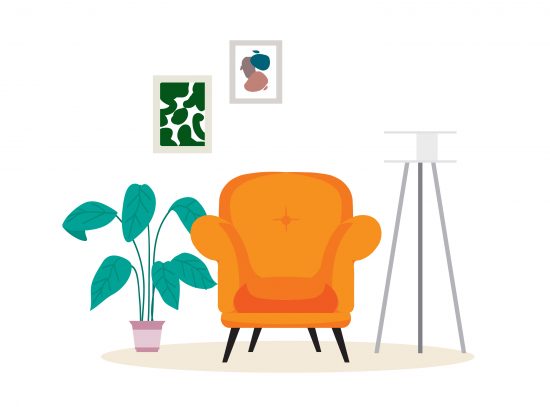
SOARING STYLE
Georgia Southern Interior Design Program Produces Leading Professionals
Interior designers are passionate about their profession. They enjoy creating living and working environments that are functional, comfortable and pleasing to the eye. But pursuing a career in this complex field takes more than creativity, it requires specialized skills. In Georgia Southern’s interior design program, students are taught the fundamentals of design in order to satisfy the wants and needs of their clients.
“Students have been studying interior design at Georgia Southern for a very long time,” noted Beth Myers, chair of the School of Human Ecology, which houses the interior design program in the College of Behavioral and Social Sciences. “During the 1960s, the home economics major had an emphasis in home furnishings and interior design. In 1990, the degree became a Bachelor of Science in Family and Consumer Science with a major in interior design and housing. Now, the degree is a bachelor’s in interior design.”
Students in the design program are offered classes in a range of fundamentals that include drawing, design studio, lighting, computeraided design, building codes and regulations, textiles, professional practice and many more. The curriculum is guided by the standards and expectations of the Council for Interior Design Accreditation.
“We use high-impact teaching and learning strategies with an emphasis on well-being and sustainability,” said Beth McGee, assistant professor of interior design. “These are applied to progressively more complex problems through using the design process with an emphasis on integrity, openness, diversity and inclusion.”
When students graduate from Georgia Southern, they are prepared for internships and career opportunities in commercial and residential design.
“We have alumni in fields like yacht and aviation design, as well as small business owners to others working at companies like Google,” said McGee. “This field is all about serving others and making people’s lives better through the built environment. There are a wealth of diverse career plans that are customizable to individual skills and interest areas as well, that can flex during changes in the market.”
— Sandra Bennett
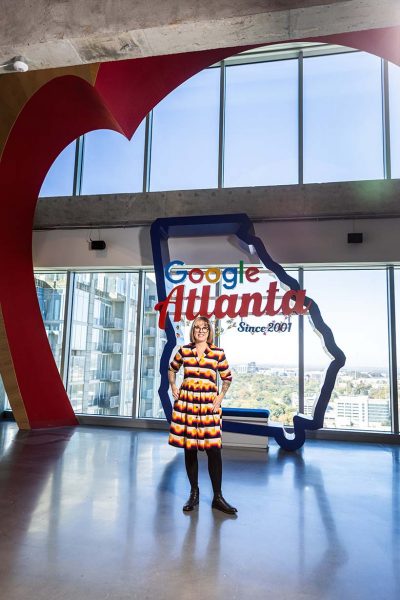
Jessica Suarez
Global Workplace Programs Design Systemization Lead at Google
If you’ve ever googled the offices at Google, you know they have some of the most stylish, colorful and otherworldly working spaces and amenities in the world. Each one of those spaces need to be designed, whether they are cafes, workspaces, conference rooms or health and wellness spaces.
Behind many of those designs is Jessica Suarez (’08), Global Design Systemization Lead at Google.
“We have fitness spaces, massage rooms, boutique fitness spaces, locker rooms and event spaces,” said Suarez. “We hold a lot of internal and visitor-facing guest experiences which includes event spaces, cafes, merchandise stores, and pop-up art experiences. Our amenities programs support each individual’s lifestyle and interests, building a community internally at Google and externally with the surrounding neighborhoods. It is what makes Google ‘googley.’ Some of our amenities programs include music rooms for anything from a solo practice room to a full orchestra space to our maker rooms to help encourage craftmaking on campus, from crochet to pottery and painting.”
It takes a talented person to juggle all those moving pieces. Suarez is just that person. She makes everything go smoothly by leading the strategy and development of tools Google uses to design all of its global amenities.
The Atlanta-area high school graduate wasn’t sure about a professional career path when she enrolled at Georgia Southern. She thought about pre-law and even education before choosing interior design.
Suarez was sure she didn’t want to follow her father’s footsteps in multicultural marketing, but through her dad’s introductions at McDonald’s, she secured an internship there. She worked at McDonald’s Chicago headquarters, helping them roll out their McCafé concept restaurant. From that moment, Suarez knew that majoring in design was the right decision.
Suarez graduated just in time for the Great Recession of 2008 and struggled to find a job. She actually took on substitute teaching roles before landing her first full-time job as project manager at a countertop company, demonstrating her resilience and resourcefulness.
From there, she held various design positions and finally got a chance to go back to McDonald’s, designing front-of-house, custom seating and decor elements for their restaurants. After a reduction in force at McDonald’s, Suarez held design positions at Ivan Allen Workspace, Focus Brands restaurant group and their Cinnabon franchise. Then, she plied her design skills at International Hotel Group, where she was a design manager for some of their brands such as Staybridge Suites and Crown Plaza.
“One day, a recruiter for Google reached out to me on LinkedIn,” said Suarez. “They asked me if I was interested in a design position. I actually thought they had read my LinkedIn profile wrong. We kept communicating back and forth because I wanted to make sure they understood my background was interior design, not graphic design or user experience. They said yeah, they hired people like me all of the time. They flew me out to California. I had five interviews in a day and by the end of the week, I found out I had the job. I thought,‘I guess I’m moving to California.’”
Despite initial doubts, Suarez embraced the opportunity. She started as the food program design manager at Google, responsible for developing design guidelines and cafe concepts worldwide. Once proven successful with the food team, her role continued to expand to support health and performance spaces, event spaces, music and art rooms, maker spaces and digital experiences.
Suarez’s role at Google has expanded considerably over the years, moving from design roles to more chief-of-staff position within her team.
“My career evolved from being primarily design-focused to taking on a leadership role with a strong emphasis on operational strategy and efficiency,” she said. “I lead efforts to manage budgets, set organization-wide goals, enhance communication, optimize processes and foster team culture.”
Her career has brought her back to the Atlanta area, too. After working remotely in Atlanta during the pandemic, Google offered the chance to relocate to their department’s hub in Atlanta, and she jumped at the chance.
“I wanted to take full advantage of moving back because my family and friends are here,” explained Suarez. “I love working on the East Coast, I am very productive in the morning while California is still sleeping. And I connect with a lot of people around the world, so the East Coast is perfect for that. But it’s more of a personal reason of wanting to be closer to my family.”
Suarez’s story encourages current and future students to make the most of their educational experiences, learn from their professional challenges and embrace the opportunities that come their way.
She also emphasized the practical aspects of her education, saying, “My time at Georgia Southern taught me valuable skills like building a portfolio, crafting résumés and mastering the art of networking.”
When reflecting on her own experiences, Suarez said, “Education is a stepping stone, but personal drive and determination are the key to career success.”
— Liz Walker

Jana Newsome Valdez
Principal Interior Designer at Haven Design and Construction
In 2000, Jana Newsome Valdez was just two credits shy of a public relations degree from Georgia Southern University when she made an impractical and giant leap, dropping her major to enter the Interior Design Program. The switch would require three more years of classes. “My academic advisor was like, ‘You cannot even consider quitting. You’re almost done,’” recalled Valdez. “And I said, ‘No, this isn’t my passion. I want to be passionate about something.”
Choosing Georgia Southern had been an easy choice. Valdez’s family history traces an almost complete map of Eagle Nation’s evolution: her grandmother attended the Georgia Normal School, her parents, James and Rebie Newsome, met on Sweetheart Circle while completing their studies at Georgia Teachers College, and her sister graduated from Georgia Southern College before Valdez and her brother would go on to earn degrees from the University.
Yet, Valdez spent semesters at an impasse after matriculating to the Statesboro Campus as an undeclared major. Eventually, she tried education and then journalism before landing in public relations out of necessity. She had to declare a major to graduate. But her gut told her there was more.
It was a move to her grandfather’s 1940s cottage in Statesboro that ignited the hunch.
The small home needed a lot of work, and Valdez’s dad wasn’t sure that she would want to live there. But Valdez immediately saw what it could be. She used what minimal resources she had to bring it up to date; painting, hanging window treatments that she crafted out of tablecloths, and purchasing cut-and-peel stick tiles, which she applied as a new kitchen floor. Her hands were blistered, but she was happy and flooded with inspiration. Friends and relatives took note.
“Everybody that came to the house was like, ‘Oh my gosh, you should have been an interior designer,’” she recalled. “And I was like, ‘no, no, no, it’s too late. I’m about to graduate.’ And they were like, ‘No, you’re really good at this.’”
Valdez tried her best to avoid any interruption, but her intuition wouldn’t shake loose.
“I kind of had a little meltdown moment in the middle of my living room floor with the course catalog and literally lay it on the floor and cried because I knew that’s what I wanted to do,” she said. “I was like, ‘why did I figure this out now?’”
Valdez made an appointment with Diane Phillips, who was the interior design program coordinator at the time. Phillips asked her if she was sure she wanted to move forward, citing the new time commitment.
“This is what I need to do,” Valdez told her. “This is what I am meant to do. I know this now. And it did take me three more years to finish, but it’s the best decision that I ever made.”
Today, Valdez is the principal interior designer for Haven Design and Construction in San Antonio, Texas, a celebrated company that she co-owns with her husband and general contractor, Armando. Together, their firm has accrued multiple honors from the American Society of Interior Designers (ASID), including the Legacy of Design — ASID Texas Chapter Best in Show Award in the categories of Black and White Kitchen Design in 2018 and the Fossil Creek Kitchen Design in 2019. The firm also earned accolades from Luxe RED Residential Excellence in Design and the National Association of the Remodeling Industry, among many others.
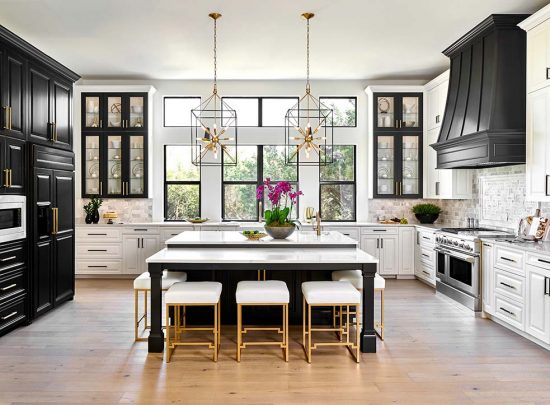
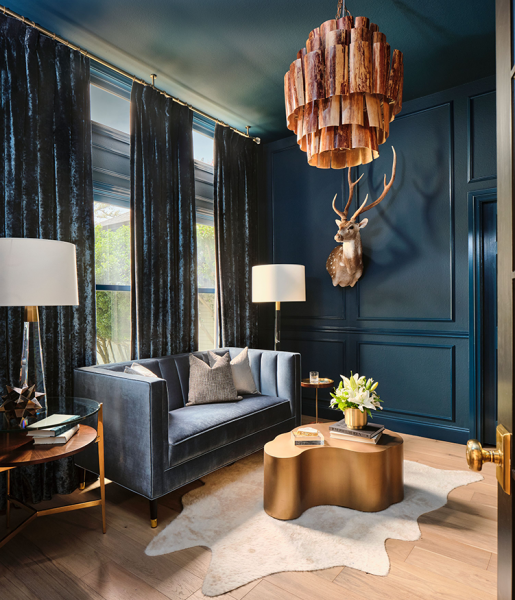
“I’m very fortunate because when I first started going to school, I had no idea what I wanted to do,” said Valdez. “Now I realize after all of my years of experience in design what a great program that Georgia Southern has. I’m really happy that I went through that program because I feel like it prepared me for any and everything that I have faced in the many different places I worked before I started my own business.”
The Interior Design Program was rigorous.
“We had really amazing professors and we worked really hard,” remembered Valdez. “We were up there until 3:00 in the morning with our bedroom slippers on, and some of us kept a toothbrush in the bathroom.
“People don’t realize how much is involved with being an interior designer. All the drawings and AutoCAD and building codes — it’s way more than pillow-fluffing.”
At the intersection of art and science, Valdez fully embraced her studies in residential and commercial design. In her second year of the program, she secured a job as a tour guide in Savannah. Showcasing the beauty of the downtown district’s architecture, landscapes and history greatly influenced Valdez’s work that she continues today.
Upon graduation, Valdez worked with fellow Georgia Southern interior design graduate Natalie Howard (’90) at her company, Bright Ideas, in Statesboro for three years. In the new residential construction sector, she put cohesive lighting packages together for builders and homeowners in Statesboro and Savannah.
Over the next several years, Valdez followed job opportunities in Atlanta, South Carolina and across Texas. Along the way, she gained experience in luxury kitchen and bath design, fusing functionality and beauty, and stone and tile, creating custom fireplaces and exterior stone facades as she sourced directly from quarries. A two-year stint with giant Ethan Allen allowed her to assist clients with various elements of home design, from furniture and window treatments to rugs and art. Finally, in San Antonio, she was wooed by the artistry of a custom cabinetry company.
Soon, however, she met Armando, and they ventured off on their own in 2016 to co-create a design-build firm that allows her to draw on the breadth of her career.
“It’s kind of incredible how everything worked out,” said Valdez. “I’m grateful that I got to specialize in cabinetry and furniture and tile and lighting because it really prepared me for where I am now.”
In 2018, the business radically changed after the award-winning, black-and-white kitchen that they created went viral. Requests from out of state began pouring in from homeowners, including executives and NFL players in Nebraska, Colorado, Massachusetts, Georgia and Texas, seeking their services.
Each project requires months of conversations and engagements with clients that revolve around function, design, layout and material approvals. The entire process can take anywhere from eight months to two years to complete, resulting in a build-out that transforms personal spaces and lives.
While the scale of her work has grown, Valdez is still moved by the same inspired creativity that bloomed in her grandfather’s cottage more than 20 years ago.
“It’s why I do what I do,” Valdez said. “I mean, it’s the best feeling in the world, really. It’s very rewarding, especially when the clients are really happy.”
As the company shifts to exclusively focus on new construction projects, Valdez is proud to continue honoring her Georgia Southern roots, as their company employs alumna Jennifer Long Price, a senior designer based in Marietta, Georgia, who graduated in 2003 with Valdez, as well numerous Georgia Southern interns since opening the firm.
“I love what I do and I still have a huge affinity for Georgia Southern,” said Valdez.
— Melanie Simón

Quintel Gwinn
Principal Designer at Quintel Gwinn Studio
In high school, a field trip to the High Museum of Art in Atlanta had a profound impact on Quintel Gwinn’s (’07) life. The exhibition of decorative arts and design, especially the modern furniture of the 1940s and ’50s, captivated her. Seeing the artistry in everyday objects designed by visionary architect Frank Lloyd Wright ignited Gwinn’s interest in architecture, furniture design and interiors.
“The knowledge that there was a person and creative process behind the design of everyday objects and household items really intrigued me,” Gwinn said. “I knew then, at the early age of 16, that I wanted to be a designer. I wanted to explore color, form and art in ways that made everyday life interesting. I wanted to create new experiences in places that were familiar to me and through thoughtful design, make them more enjoyable.”
So, when Gwinn arrived at Georgia Southern University, she knew exactly where her career path would lead, based on her research of leading interior design programs at colleges across the state.
“I learned that the Georgia Southern design program was accredited by the Council for Interior Design Accreditation (formerly FIDER) and by the National Association of Schools of Art and Design,” she explained. “In comparing programs of study across the state, I understood how important this designation was and the way it would shape my academic experience and future career opportunities.”
But there were other reasons why she chose Georgia Southern. “I fell in love with the campus during a college tour,” said Gwinn, who grew up in Columbus, Georgia.
“At first sight, it was a dream — and still is. I wanted a complete university experience where I’d live in a dorm, enjoy campus life, and have a safe, resourceful and enjoyable place to grow. As a first-generation college student and HOPE scholar, this was crucial.”
After graduating, the alumna honed her skills and gained invaluable hands-on experience as the in-house interior designer for John I. Rivers Architects, an African American architectural firm in her hometown. However, she was laid off during the Great Recession of 2008-09. That’s when she moved to Charlotte, North Carolina, where she eventually opened her own business, concentrating on community-based projects and home renovations. Projects that challenge her to reimagine space excite her the most.
“I’ve come to do a lot of work in the city that is centered around how to reclaim space, how to bolster neighborhoods, how to help with erasure, cultural erasure and identity, and the role that space can play in that, whether it’s adaptive reuse or if it’s thinking about spatial updates that a neighborhood or community or area can make,” the designer said. “Once I converted a vintage school bus into a mobile hub, and renovated an old church into a community center. I’m drawn to out-of-the-box opportunities that stretch my ability to think creatively and expand the way I apply my skills as a designer.”
The booming Charlotte real estate market helped Gwinn grow her business. She works with clients of all cultural and ethnic backgrounds but said most are African Americans.

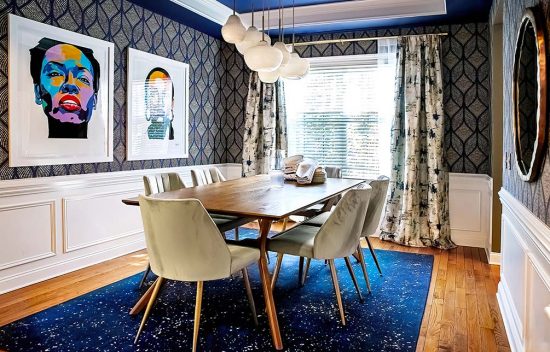
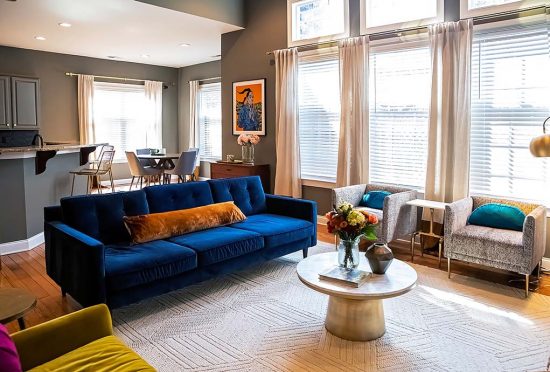
“To work in that space was intentional,” she explained. “When I started in Charlotte, I didn’t have many black clients. So, I attended networking events focused on black businesses and black neighborhoods to reach people who would be interested in my service. Now, when clients have a special cultural lens or feeling or vibe that they want to add to their space, I’m the person who can navigate products on the market that may not be geared toward black people, but I can pull things together in a way that will resonate with them.”
Pandemic lockdowns created new opportunities for interior designers. As more people worked from home, they needed to make changes to their living spaces. Some tackled do-it-yourself home improvement projects, while others opted for professional assistance.
“The pandemic pushed people to rethink and reimagine their homes and make the best use of their space or get more bang for their buck,” Gwinn said. “They had to create home offices on the fly. Many realized they were paying for underutilized square footage while being away at work, and that prompted them to change unused dining rooms into offices and dens, or convert spaces into movie rooms or lounge areas.”
Although supply chain and manufacturing problems hampered business as the pandemic lingered, Gwinn kept her focus on loyal clientele who valued her personalized service. Now that she has an established clientele, the divorced mother of three is shifting gears. She is on track to become a full-time tenured professor of design at Winthrop University.
“I’m at a place now where I can be selective with clientele,” said Gwinn. “I don’t have to take every project that comes my way. I still want to practice because being a practitioner adds richness and so much value as an educator because it just keeps you on the pulse, in the know, and aware of how the industry is changing. And that’s going to benefit students so much.”
During her undergraduate experience, Gwinn had jobs on campus and joined the Xi Eta Chapter of Delta Sigma Theta, Inc. She credits Georgia Southern’s interior design program faculty members with preparing her to become a successful business owner and professor.
“I received a first-class design education at Georgia Southern, guided by amazing professors who were passionate about interior design and who brought industry experience and excitement to the classroom,” she said. Gwinn recalled the one class that left its mark on her — a lighting design course taught by Diane Phillips, who is an assistant professor emerita. Gwinn admired her patience, dedication and her skill in motivating students to discover their unique creative styles. Gwinn laughed as she shared, “During the recent spring semester, I taught an interior design class. And guess which course it was? Lighting Design!”
Her journey had come full circle — inspiring students just as the Georgia Southern professor had inspired her.
— Sandra Bennett
